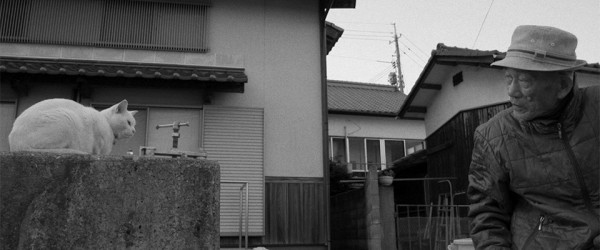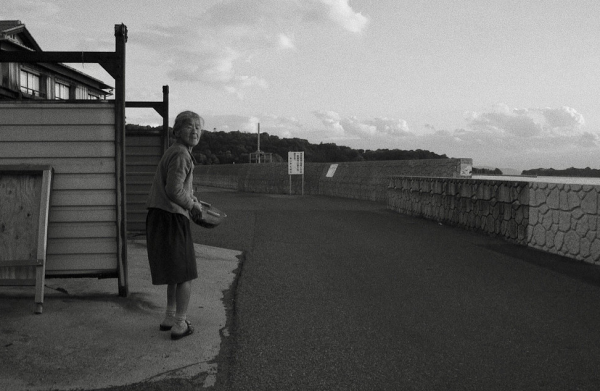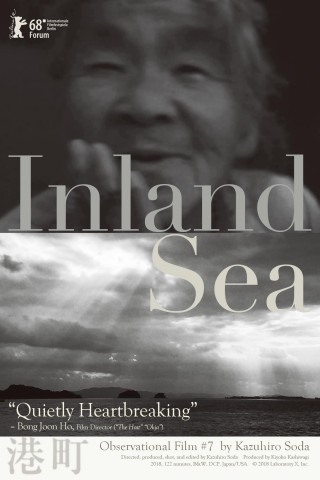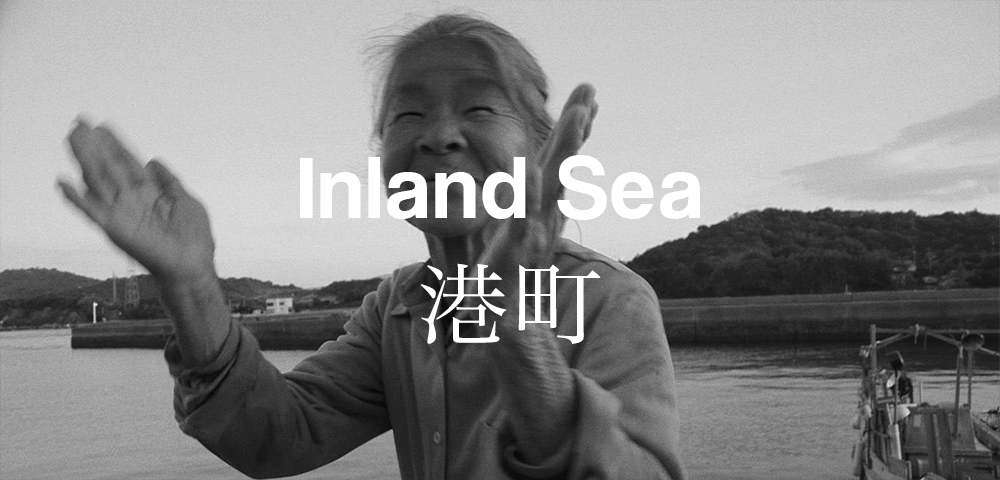Los Angeles, CA – Nov 26, 2019 – ROCK SALT RELEASING has released Kazuhiro Soda’s silent observational doc, ‘INLAND SEA’ (aka ‘Minatomachi’), is now available on various streaming platforms.
Watch INLAND SEA on Vimeo on Demand here: https://vimeo.com/ondemand/inlandseaftr.

An online tourist description of the town of Ushimado says, “The seaside resort town of Ushimado overlooks the numerous beautiful islands dotting the Setonaikai (The Inland Sea)… visitors can watch the sun set and enjoy a romantic evening on the town.” (Explore Okayama, Okayama Prefecture Official Tourism Guide, www.okayama-japan.jp/en/spot/1075).
Visiting Ushimado for a romantic couple’s getaway is the last thing anyone would expect to do after watching Kazuhiro Soda’s 2018 documentary, titled geographically: Inland Sea, 2018, Observational Film #7. But the title, while accurate as to the lay of the land, also implies a sort of insular, insulated, cut off quality of both landscape and people. And that is what, it turns out, Soda – and the audience – observe throughout the film. The documentary covers only the population aged 85 and older; yet, from the film’s dialogue and intentional direction, we are given to understand that is mostly the only age range that occupies Ushimado. It is a dying town.
Soda’s film follows several elderly residents who are connected, for the most part, to the town’s fishing industry, which is not exactly booming. The main characters include Wai-chan, a fisherman; Kumi-san, a woman who loiters about the dock for seemingly no particular purpose; Koso-san, a fish monger who tracks down her clients by phone and by auto; and two people (possibly mother and son or brother and sister) who purchases fish scraps in order to feed the town’s over-abundant population of stray cats. As for the cats, they could be considered another character of the film, as they receive ample film time, are a constant topic of conversation, and observing them adds to the lethargic feeling present in the town and the film.
According to Soda’s biography on his artistic webpage, Soda is known for a style of documentary in which he follows his self-imposed “10 Commandments.” These “Commandments” mean that he does not allow himself any “pre-shoot research or writing a synopsis before filming…in order to minimize preconceptions and to be able to make unexpected discoveries while filming and editing”. It’s true that Inland Sea is a documentary full of slow and wondering discoveries; yet one does wish after about midway through, that Soda had more of a plan. The first few major portions of the documentary make sequential sense. We begin at the dock, and follow Wai-Chan out onto the water to watch him fishing. We get a full sense of his isolation, and the hard work and low pay he endures by pursuing, at a very old age, a very outdated method of fishing. From there, we follow Wai-Chan to the fish market, and watch as he hovers anxiously in the hopes of selling his catch. His catch does sell, though we wonder if it is not partly due to pity on the part of the buyers, who probably all know Wai-Chan well.
From the fish market, we spend a good deal of time with the female fish seller, watching her and a family or staff member prepare the fish for sale, and then her somewhat unique method of tracking down her clientele one by one, by foot or by car if she has to. It’s part customer service and part desperation when times are tough. One set of customers is the woman and man who take a bag of fish scraps home to feed the cats. Everything thus far is a logical and satisfying chain.
Then things start to drift. We wonder if Soda has run out of things to film, if he has an overarching outline, or if he is simply “going with the flow,” apropos perhaps in a fishing town, but a bit unsettling and restless-making for the viewer. A neighbor wanders by during the cat feeding mentioned above, and Soda simply follows her. There doesn’t seem to be any indication that he meant to ahead of time; rather, it seems spontaneous. We wonder if the neighbor minds being followed! And in fact, there is a lot of nervous and polite laughter in the film, which begs the question as to how happy the subjects are about being filmed. The woman goes to tend gravestones at a rather dilapidated cemetery on top of a hill with a marvelous view. We can hear the ocean and the sounds of motors as fishing boats (and maybe tourist boats?!) ply the water below. The sense of tranquility that absorbs the film off and on is at full force in the cemetery.
But what now? We’re back on the dock. The film from this point hones in on the elderly female dock loiterer. She wears a skirt, socks, and sandals in what seems to be cold weather. She is constantly rubbing her hands together. She has a frayed look and behaves like a mechanical object that has outlived itself but really can’t do anything about it except keep going. We begin to realize that, while we thought at the beginning that Wai-Chan was the main focus, this woman is going to carry us through to the end of the film, and we learn more about her than anyone else.
The subject in the air during the entire documentary is death. These people are near to it. What do they think about? Do they think about it? Wai-Chan says out on his boat, “You get older without knowing it.” The fishmonger is reluctant to tell her age. But the old woman on the dock is the most heartbreaking. With a blind son taken from her by an institution she claims just wants to receive government funding, this woman actually does have a home – but she refuses to stay there because she doesn’t want to feel alone. When her son was taken away, she attempted suicide by walking into the water, but policemen and a nephew who lives in Ushimado kept her from doing so. “I still think about killing myself,” she says, not making eye contact. “No use of living. I’m only alive because I’m alive.” Her son, she says, was the reason she was alive. “It might be nice to end everything.”
Was that the punch Soda was waiting for, or was it just a coincidence?
All of the sudden, on the back of these sobering revelations, pleasant goodbyes are said. The woman laughs, “Let’s meet [next time] if I’m still alive.” It’s a strange feeling, knowing that Soda and his wife, who was there with him, will be returning to New York, where they live, and in a sense, also “abandoning” this town and these people now that he has accomplished his goal. It makes you wonder, what is the goal of this documentary? Is it like the days of the extermination of Native Americans in the U.S. in the 1800’s, when photographers and writers recorded the lives of the indigenous people as if they were already dead? Is it a call to action for the plight of the elderly? Is it an appeal, Mark Wahlberg style, for the dying fishing industry? Or is it simply watching? No goal other than showing us a slice of the life and/or death of a town and its people – probably the last. Yet, based upon the prefecture’s description attracting tourists to enjoy Ushimado’s beautiful sunsets and spend “a night on the town” – we wonder whether or not Inland Sea is truly a full slice of life in Ushimado. Or if it’s just that its elderly residents are truly forgotten and truly invisible – if not for Soda’s camera.
Review written by: Kai Curry.

ROCK SALT RELEASING has released INLAND SEA onto various digital platforms today, Nov. 25th (InDemand, Amazon, Hoopla, FlixFling, Vimeo on Demand, Vudu, FANDANGO).
Watch the trailer for INLAND SEA here: https://www.youtube.com/watch?v=YZ3Zi62zt_0.
For more information, please visit: https://www.kazuhirosoda.com/inlandsea and http://rocksaltreleasing.com/inland.html
For general inquiries, please contact sales@rocksaltreleasing.com and for press inquiries, please contact jenna@tricoast.com

INLAND SEA (2018, 122 min.) Directed and written by Kazuhiro Soda. Producers: Kiyoko Kashiwagi, Kazuhiro Soda. Editor: Kazuhiro Soda. Cinematographer: Kazuhiro Soda. Japan/USA, Japanese/Silent. Laboratory X, Rock Salt Releasing, TriCoast Worldwide.
PRODUCTION COMPANY: Laboratory X – Kiyoko Kashiwagi, Kazuhiro Soda.
ROCK SALT RELEASING: Daisy Hamilton and Dean Fernando.
About TriCoast Worldwide:
TriCoast Worldwide is a premium international sales agent, representing the best of US and international films at all the major film markets. Sister company to TriCoast Entertainment and TriCoast Studios, the company is located at the Studio facility in Culver City, Los Angeles.
Founded by: Strathford Hamilton and Marcy Levitas Hamilton
Media Contact
Company Name: TriCoast Entertainment
Contact Person: Jenna Wilen
Email: Send Email
Phone: 3104587707
Address:11124 Washington Blvd.
City: Culver City
State: California
Country: United States
Website: http://www.tricoastworldwide.com

